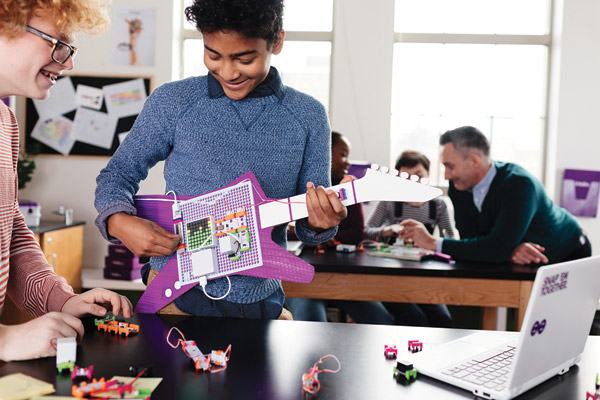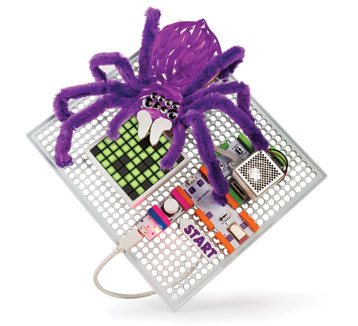Coding Made Inventive: LittleBits’ Code Kit | SLJ Review

Keytar
“Make Something That Does Something.” With the launch of the littleBits Code Kit, the tagline of the company known for its electronic building blocks is truer than ever. The kit, which has been in development for over a year, is a suite of hardware, software, and resources that work together to teach kids, grades three through eight, how to apply computer code to their inventions.
Features
In the hardware department, there are two new notable additions to the littleBits family: the codeBit and the LED matrix bit. The codeBit is described as the “brain” of the littleBits family and is essentially a tiny computer. It has three input ports and an equal number of output ports, each of which can be programmed using the free littleBits Code Kit app. The codeBit is accompanied by a dongle that plugs into a USB port, allowing the codeBit to connect to the computer wirelessly.
The LED bit is the new output and spotlights coding skills. It’s an eight-by-eight, illuminated matrix that can display images and scrolling text in 23 colors. The matrix can be set to a serial mode for programming the scrolling text and changing images, and a signal mode, which responds to incoming signals, thus useful for scorekeeping. Also included in the Code Kit ($300; compatible with Mac, Windows, and Chromebook) is the new and improved speaker bit, as well as a USB power bit with a rechargeable battery and three powerSnaps that allow multiple branches of the circuit to come into the codeBit, powered by one source. In all, the kit contains 16 bits and 30 accessories. The accessories are a collection of mounting materials that make it easier to attach the circuit and the mounting board to a surface, and servo bit accessories facilitate incorporating the waving robot arm into a design.
Hot Potato... of Doom!
The codeBit works by uploading programs written in the new Code Kit App. The coding language is based on Google’s Blockly, a drag-and-drop block-based language. Students who are familiar with Blockly, Scratch, Hopscotch, or another block language should have no problem with the app. It’s basic enough for novice coders to create simple programs with fun results, but will also be appreciated by experienced students (and curious adults) who want to create something more complex. Four sample projects can be scaffolded to teach users the language, each one making use of a different set of bits and code. The most advanced project, “Tug of War,” is an excellent example of the more sophisticated programs that can be created with the language. This program uses functions, variables, and loops, along with mathematical components. Remixing this code to implement one of the “level up your game” prompts is a challenge and will give users a glimpse into what it takes to be a programmer. The last piece of the littleBits Code Kit suite is a collection of resources for makers and educators. These project examples and tutorials can be accessed from the Code Kit app homepage. Educators looking to integrate the Code Kit into their curriculum will find a strong collection of support materials available. It is entirely possible for a group of students (littleBits recommends two to three students per kit) to simply open the box and see what they can do. But for classroom teachers who want more structure, a curriculum guide is available, as are detailed lesson plans, a standards crosswalk that links Code Kit projects to Computer Science Teachers Association (CSTA) and Next Generation Science Standards (NGSS) Engineering Design standards, reproducible handouts, and a student workbook for recording ideas and progress. Don’t overlook the brief but useful implementation checklist—it’s sure to reduce the number of teacher headaches.VERDICT
The ability to integrate code into a littleBits project already exists in the form of littleBits’s Arduino Bit. The littleBits Code Kit is more than a single bit that reads and runs programs—it’s a thoughtfully designed and constructed curriculum. The app and Blockly-based language make for an excellent entry point for novice coders and inventors, while the LED matrix offers numerous creative possibilities. In addition, the sample projects are ripe for remixing (beginning with the “level up your game” prompts). Teacher resources are both comprehensive and useful. Those resources, coupled with the community of inventors already gathered on the littleBits website, indicate help for every question that arises is never  far.
far.
RELATED
The job outlook in 2030: Librarians will be in demand
The job outlook in 2030: Librarians will be in demand
ALREADY A SUBSCRIBER? LOG IN
We are currently offering this content for free. Sign up now to activate your personal profile, where you can save articles for future viewing







Add Comment :-
Be the first reader to comment.
Comment Policy:
Comment should not be empty !!!